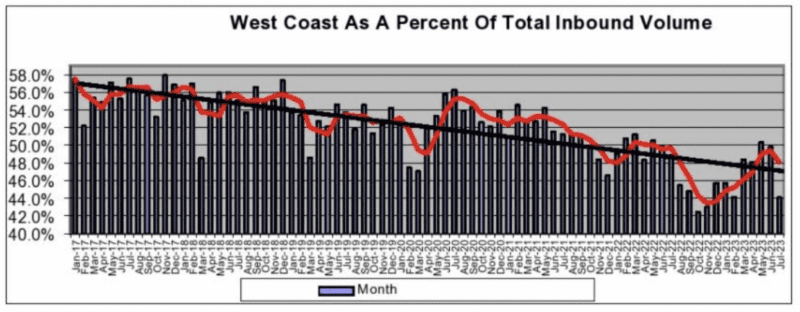Cocoa Piles Up At Ivory Coast Ports As Buyers Face Cash Shortage
By Baudelaire Mieu and Mumbi Gitau Dec 5, 2025 (Bloomberg) –Ivory Coast is facing a temporary glut of cocoa at its ports as farmers rush to find buyers due to falling...
A new study has found that climate warming greenhouse gas emissions increase when imported cargo from Asia is diverted away from U.S. West Coast ports to the East and Gulf Coast.
The study, released this week by the West Coast-based Pacific Merchant Shipping Association, analyzed a number of factors including port of origin, port of destination, ultimate inland destination and vessel sizes.
The analysis evaluates the relative differences in GHG emissions between the traditional shipping routes from the Far East to U.S. West Coast ports and inland U.S. destinations, to longer routes through East and Gulf Coast ports.
California and Pacific Northwest (PNW) ports offer the most direct shipping route from Asia to the U.S. and inland U.S. destinations. However, the U.S. West Coast has been losing market share to other ports on the East and Gulf Coasts fairly steadily since the opening of the expanded of the Panama Canal in 2016.
California’s Port Dominance Slipping as Cargo Shifts East
This shift was exacerbated during the pandemic-fueled imports surge due to West Coast port congestion, followed by protracted labor negotiations that have since been settled. While West Coast ports have regained some of their market share this year, the eastward shift is expected to continue.
The shift is illustrated in the graph below provided by industry analyst John McCown:

The study demonstrates that U.S. West Coast ports largely have an environmental advantage over East Coast and Gulf ports in the total GHGs emitted per container, due to longer transit times and distances.
The study found that GHG emissions are, on average, are 19% higher when cargo is shipped through East Coast or Gulf Coast ports over the ports of Long Beach and Los Angeles, with emissions doubling when shipped through the Port of New York & New Jersey. Moving cargo through Savannah, GA rather than the PNW increases GHG emissions by up to 94%, while moving cargo through the Gulf Coast rather than the ports of Long Beach and Los Angeles increases emissions by up to 64%.
“This study demonstrates the environmental risk associated with cargo diversion,” said Thomas Jeleni?, Vice President of the Pacific Merchant Shipping Association (PMSA). “Public officials must take a holistic approach when it comes to climate change policies. Doing so is essential in keeping cargo and union jobs at the nation’s cleanest ports here on the West Coast, as well as ensuring that GHG emissions are simply not being shifted elsewhere.”
For the study, conducted by Starcrest Consulting Group, analyzed emissions associated with vessel routes from South Korea, China and Singapore to West Coast, Gulf Coast and East Coast ports via the Pacific Ocean, Suez and Panama canals, with ultimate destinations of Chicago, St. Louis and Memphis.

Sign up for gCaptain’s newsletter and never miss an update

Subscribe to gCaptain Daily and stay informed with the latest global maritime and offshore news
Essential news coupled with the finest maritime content sourced from across the globe.
Sign Up